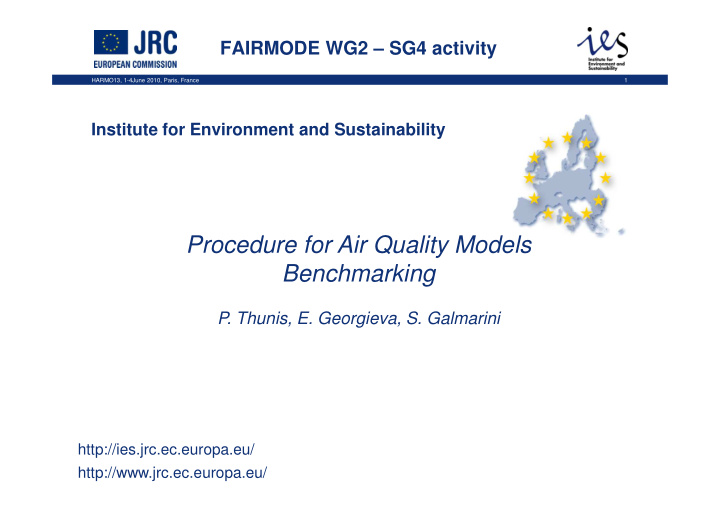



FAIRMODE WG2 – SG4 activity HARMO13, 1-4June 2010, Paris, France 1 Institute for Environment and Sustainability Procedure for Air Quality Models Procedure for Air Quality Models Benchmarking P. Thunis, E. Georgieva, S. Galmarini http://ies.jrc.ec.europa.eu/ http://www.jrc.ec.europa.eu/
Outline 2 HARMO13, 1-4June 2010, Paris, France • Objectives & Background • Key elements of the procedure • The Benchmarking service • Usage of the procedure • Usage of the procedure • Work Plan • Contributions & links to other SG
Objectives 3 HARMO13, 1-4June 2010, Paris, France • Develop procedure for the benchmarking of AQ models in order to evaluate their performances. • Support both model users & model developers in the implementation of the AQD (Assessment & plans) • Provide technical/scientific support to policy on the analysis of the quality of model results analysis of the quality of model results • Identify a common scale for model evaluation • Identify a common (= to all member states), permanent (= through directives) and periodic (= every x years) practice to assess model quality improvement
Background (II) 4 HARMO13, 1-4June 2010, Paris, France Many tools & methodologies already existing… • BOOT software (Chang and Hanna, 2005) • Model validation Kit (Olesen) • USA-EPA AMET package (Appel and Gilliam, 2008) • CityDelta and EuroDelta projects • E NSEMBLE platform (Galmarini S. et al. 2001, 2004). • E NSEMBLE platform (Galmarini S. et al. 2001, 2004). • PM model performance metrics (Boylan and Russell 2006) • Summary diagrams (Jolliff et al. 2009) • SEMIP project • EPA Guidance (2007, 2009) • AIR4EU conclusions (Borrego et al. 2008) • ASTM Guidance (ASTM, 2000) • Mesoscale Model Evaluation – COST728 (Schluenzen & Sokhi, 2008)
Background (III) 5 HARMO13, 1-4June 2010, Paris, France - Proposal for a Benchmarking Tool: FAIRMODE WG2 Meeting November 2009 - Document “ Procedure for AQ models Benchmarking” sent out to SG4 participants April 2010 (uploaded on FAIRMODE web page) April 2010 (uploaded on FAIRMODE web page) - Application types: AQ assessment and Planning - Models included: Regional, urban and local scales - Focus: pollutants considered in the AQ Directive (NO2, PM and O3) depending on the spatial scale addressed.
Key elements of the procedure (I) 6 HARMO13, 1-4June 2010, Paris, France DELTA : Evaluation tool based on City- & Euro- Delta inter- comparison exercises ENSEMBLE Multi-model evaluation and inter-comparison platform used by several modeling communities (e.g. Galmarini S. et al. 2001, 2004a and b). Data Extraction of Monitoring data, Emissions, BC… Extraction links to other projects data (GMES, EC4MACS…) Benchmarking Performance indicators, criteria and goals, summary Service reports.
The benchmarking service 7 HARMO13, 1-4June 2010, Paris, France PURPOSE : produce summary performance reports for a given model application in the frame of the AQD. FEATURES : • Reports follow a pre-defined template structured around a • Reports follow a pre-defined template structured around a core set of indicators and diagrams. • Definition of some bounds for specific indicators, called hereafter goals and criteria (regularly revised based on future joint modelling exercises). • Decomposition of the evaluation in temporal and spatial segments on a reduced dataset but for an entire year. • Reports are obtained through an automatic procedure
The benchmarking service Core set of statistical indicators 8 HARMO13, 1-4June 2010, Paris, France • R Correlation • B Bias • SD Standard deviation • FAC2 Factor 2 • RMSE Root Mean Square Error • RMSEs Systematic RMSE • RMSEu • RMSEu Unsystematic RMSE Unsystematic RMSE • CRMSE Centered RMSE • IOA Index of Agreement • MFB Mean Fractional Bias • MFE Mean Fractional Error • RDE Relative Directive Error • RPE Relative Percentile Error
The benchmarking service: Summary diagrams 9 HARMO13, 1-4June 2010, Paris, France Bugle plot (boylan 2005) Target plot (Jelliff 2009) Criteria: Acceptable performance for a given type of application (e.g. PM: MFE=75%, MFB=+/-60%) Goal: Best performance a model should aim to reach given its current capabilities (e.g. PM: MFE=50%, MFB=+/-30%) Observation Uncertainty
The benchmarking service: Performance summary report 10 HARMO13, 1-4June 2010, Paris, France Performance summary report (pollutant/scale specific)
Usage of the procedure 11 HARMO13, 1-4June 2010, Paris, France USER JRC Data Extraction Facility Model results BENCHMARKING DELTA service Unofficial Official Unofficial Working Report Reports Working Report
Usage of the procedure: testing levels 12 HARMO13, 1-4June 2010, Paris, France Model Results Input Consistency Indicators (ICI) (model vs. input data & min-max tests) Model Observation Indicators (MOI) (model vs. measurements) Multi-Model Indicators (MMI) (model vs model: type, version, user…) Model Response Indicators (MRI) (model vs model: type, version, user…)
Work Plan 13 HARMO13, 1-4June 2010, Paris, France - Discussion and consensus on overall methodology (FAIRMODE meeting 09/2010) - Development of the DELTA and benchmarking service prototypes (Dec 2010) - Testing of the prototypes on existing datasets (2011) - Testing of the prototypes on existing datasets (2011) - Development of the JRC Web facilities (data extraction, links ENSEMBLE-Benchmarking service…) - Set-up of a joint exercise for testing of the whole system (2012)
Contributions needed 14 HARMO13, 1-4June 2010, Paris, France • Discussion and definition of the benchmarking service elements (species, statistics, goals and criterias…) for model performance reporting per pollutant/scale (especially local scale). • Links to other SGs (station representativeness, • Links to other SGs (station representativeness, emissions…) • Definition of and participation to the joint activities
Recommend
More recommend